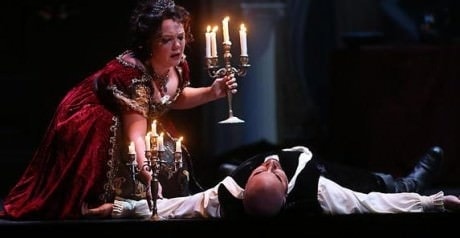Art with mysterious power can pull opposite beauties together, and there is nothing more opposing in its beauty than the elegant tragedy of a doomed love story. Played out in one of Puccini’s finest operas, The Lyric Opera Baltimore proudly presents Tosca as the start to their fourth season. Directed by James Harp with Conductor Steven White leading the Baltimore Symphony Orchestra, this stunning and dynamically moving tragedy is the epitome of operatic beauty at its finest; a brilliant rendition that pays true homage to the period of the opera and the intricate emotions woven so perfectly into Puccini’s masterpiece.

Scenic Designer Andrew Horn leaves no stone unturned when it comes to the flawless beauty of the three sets that envelop the three acts of this opera. Each one more brilliantly detailed than the last, breathtaking in their likeness to reality. Horns designs are not simply sets for which the action unfurls upon, but they are atmospheric immersions that draw the audience into the reality of the story. The opening act in the church features enormous columns and statues creating a truly holy look, the feeling of the cathedral vast and welcoming yet dangerously large at the same time. Horn’s sparse furnishings in Scarpia’s apartment create an ominous presence and the enormous mural creates a sense of perverse piety; a liar befitting of the demon that dwells within it. But Horn’s finest work is witnessed in the third act; the gorgeous castle with its brick parapets, daunting angel statue and starry night sky as the barest twinkle of twilit dawn ascends upon the scene of the execution.
The Baltimore Symphony Orchestra, lead by Conductor Steven White creates a tremendous and stunning sound more than befitting of this equally moving opera. From the moment the opera begins the well-balanced force which rises up from the pit hits your ears like melodious waves crashing to the shore in aural ecstasy. White and the BSO gently extricate emotions from scenes of reticence, filling the gaps with swells of sound that stir the soul. This is particularly true of the strings section of the orchestra, especially during moments of character introduction like when Scarpia is revealed to be truly evil. The woodwind soloist featured in Act III during Cavaradossi’s final goodbye letter to Tosca is hauntingly beautiful.
Angelotti (Ashraf Sewailam) while only encountered briefly becomes the catalyst for the action of this opera. Sewailam’s gentle bass purr is fraught with nervous exhaustion, his emotional expression clear and concise as he confides in his only confidante, Cavaradossi. Balancing out the rich full sounds of Sewailam is Spoletta (David Sadlier). His tremulous tenor voice eases through the numerous moments of recitative making his conversations flow naturally. Both Sadlier and Sewailam comprehend this complex operatic device featured throughout the performance with an excellence that leaves you fully involved in their stories, briefly as they are featured.
The eternal flame is perpetually ablaze in the voice and damnable soul of Scarpia (Raymond Aceto). His characteristic arrogance and confidence makes his villainous approach to the character deadly accurate. Aceto’s aria, “Ha più forte sapore” at the top of Act II, is filled with that tantalizingly torturous poison, burning with a full ferocity in his broad tenor range. His voice possess a true fury that builds eruptive moments of tension between he and Tosca (Jill Gardner) during the confrontation in his apartment. Their voices erupt at one another with blazing emotional flames; vocal weapons bared and prepared to duel to the death. Aceto is the epitome of a viperous demon, intent on possessing the lovely Tosca. His voice is petrifying in “Va, Tosca!” as he unleashes the demented torment of his blackened soul.
Gardner, as the show’s title character is astonishing. A true vocal phenomenon, her approach to the aria “Vissi d’Arte,” is sublime. Her voice radiates the desperation of love and regret in that moment, stirring deep from a place in her soul. Gardner’s soprano is pitch perfect, holding her extenuated notes with the perfection of vibrato. Her ability to quickly showcase love and jealousy is astounding; flipping back and forth between oozing passionate ardor and spitting vicious quips in the series of duets, “Non la sospiri, la nostra casetta” and “Qual’occhio” with Cavaradossi (Dinyar Vania) early in Act I. But the most striking duet that the pair shares is “Amaro sol per te m’era il morire” a ballad that tangles their voices aglow in a celestial fire of blissful ecstasy; their final profession of love to one another complete. Gardner as Tosca is a smashing success; bringing the audience to their feet demanding an encore by the show’s twisted end.
Dinyar Vania has an equally soulful voice and plays brilliantly opposite Gardner as Tosca. His moving aria “E lucevan le stelle” which flows with pristine beauty into “O dolci mani” draws forth tears of pure heartache as he confesses his final love to the absent Tosca. A dynamic character, Vania is the perfect fit for the role; matching Tosca passionate note for passionate note.
It is a brilliant way to start of the operatic season at The Lyric, and to see what else lies in store, be sure to visit the website of The Lyric Opera Baltimore.
Running Time: 3 hours, with 2 intermissions.
Tosca! Plays through November 3, 2013 at The Patricia and Arthur Modell Performing Arts Center at The Lyric — 110 West Mount Royale Avenue, in Baltimore, MD. For tickets call (410) 900-1150 or purchase them online.





